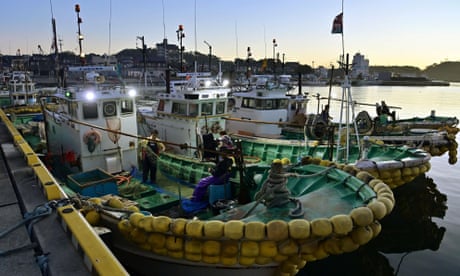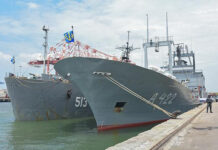Using explosives is illegal, wasteful and devastating to marine life and people’s livelihoods. Yet in Sri Lanka and around the world it’s thriving as a quick and easy route to a lucrative haul.
The immediate aftermath of a blast is obvious, says Wilson Perera: the ocean turns murky with blood and is strewn with fish that are missing eyes or other organs. Those fish that are wounded swim off to die elsewhere. Their carcasses wash ashore days later.
“Everything within a 100-metre radius of the blast is destroyed – coral reefs, marine plants and animals,” says Perera.
Perera is a fisher and supplier in Salpayaru, a picturesque fishing village near the city of Trincomalee on the north-eastern coast of Sri Lanka. He says the ocean here teemed with marine life until an increase in blast fishing began destroying its bounty.

Blast fishing, an illegal method in which dynamite or other explosives are used to kill or stun fish, takes place around the world, from South America to Asia and Africa to Europe. According to one study there were 850,000 blast fishing incidents recorded between 2006-2016 in Hong Kong, Malaysia and the Philippines alone.
The sound “echoes like a bomb blast” if near the surface, Perera says, or can be nearly silent if targeting deeper fish, where the explosives are first tied to rocks or chunks of iron.
Though illegal in Sri Lanka, the practice thrives across the island with a variety of explosives such as gelignite, watergel sticks and detonators, often smuggled from stone quarries. Between 2019 and 2023, the Sri Lankan navy said it seized 18 gelignite sticks, 12,570 watergel sticks and 3,073 detonators, but that many more slip through.
Blast fishing has clear economic advantages in the short term. Perera explains it requires only two or three people, as opposed to up to 25 fishers working together to use a beach seine, a traditional form of fishing in which a net operated from the coast surrounds an area of shallow water. With just a boat, an engine, a few dynamite capsules and an oxygen cylinder for the diver, blast fishers can get about 100kg of fish at the snap of a finger, he says.

But blasting also hurts fishers who use traditional methods, such as outboard motor (OBM) fishing and beach seine. The explosions kill juveniles and eggs, which Perera claims is contributing to declining stocks. Dynamite use also blocks schools of fish from reaching the shore, further affecting the beach seiners.
“An entire generation [of fishers] will be destitute [because of blast fishing],” he says.
Jude Ranjith, another fisher from Salpayaru who uses traditional beach seine and OBM methods, says dynamite fishers can collect huge volumes of fish – sometimes as much as 1,000kg a trip – compared with 50-60 kg for OBM fishing.
“But now there is less catch,” he says. “We used to go to sea every day but now we only go about three days a week.” He says his weekly income from OBM fishing has roughly halved.
Blast fishing is usually done by day when it’s easier to see the dead fish, but also at night when boat lights are used to attract fish. “A net is used to trap the fish gathering around the lights. Then the boat moves away and the fish are killed with a blast,” says Anton Justice Tissera, another fisher. “Because of this, our coastal jobs are gone.”
Herman Kumara of the National Fisheries Solidarity Movement, a Sri Lanka-based fisheries organisation, describes blast fishing as “the goose that lays golden eggs” for illegal fishers. As well as allowing them to collect large volumes quickly, it can be useed to stun larger fish, such as seer mackerel, that cannot be controlled with a net alone.

It is also incredibly wasteful, according to Perera. Often it is only the immediately visible fish – those floating on the surface – that are scooped up before the navy arrives. “The rest of the dead fish are completely wasted.”
More than half of the fish killed by dynamite are left behind, according to research by Prof Augustine Sosai, a retired academic from the University of Jaffna, Sri Lanka. “Dead fish wash to the shore even two days after the blast,” he says.
He notes that after nearly 50 years of blast fishing, the corals in north-west Sri Lanka close to Mannar – shallow-water reefs known for high species diversity – are “heavily damaged by dynamite”. Vulnerable species such as dugongs have been found dead in dynamite blasts, he notes, as have turtles and dolphins.
The use of explosives is banned under the country’s Fisheries and Aquatic Resources Act (Fara) and the Fauna and Flora Protection Ordinance, says Dr Jagath Gunawardana, an environmentalist and environmental lawyer.
“[Under Fara] no one is allowed to even carry an explosive in a boat – the assumption is that it is being carried to catch fish,” he says. Offenders can be arrested without a warrant by either the navy, coastguard, fisheries department or police. But the “weak point” lies in the enforcement mechanism, he says.

Susantha Kahawatta, head of Sri Lanka’s fisheries department, says it is challenging to monitor the seas 24 hours a day: “The navy is stationed in limited areas and when we inform of an incident they are deployed to the relevant areas.” Gunawardana argues that more enforcement officers should be stationed at dynamite fishing hotspots.

The challenges are not limited to Sri Lanka. Dr Kennedy Osuka, a lecturer in marine ecology at the University of Liverpool, has observed the effects of dynamite fishing in east Africa, particularly in Tanzania. “The practice endures due to inadequate enforcement,” he says. “Poverty, ineffective community-led initiatives and absence of government support contribute to this persistence.”
Back in Salpayaru, even as Perera is explaining the problem, a boat speeds by, scouting the shallow waters and apparently untroubled about being seen. “That is a dynamite boat,” Perera says, noting its evasive movements. “They are looking for a stock of fish to blast.”
The Guardian





